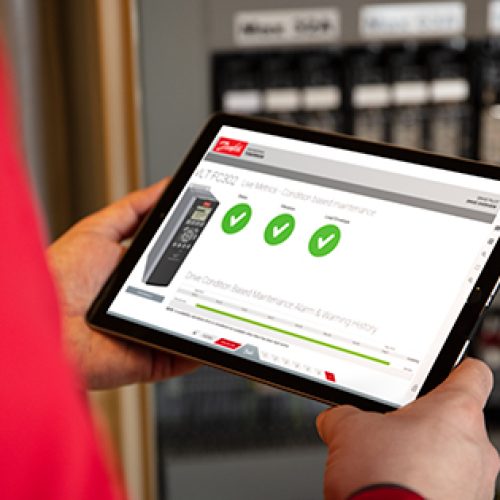How does an inverter learn?
Episode 1
Condition-based plant maintenance: When the inverter learns and errors no longer occur in the first place
In industry, few drive systems are monitored with high-end condition monitoring software – because it is often too expensive. When such a system is used, it is usually in critical areas. Engineers Jörg Dannehl and Holger Schmidt from Danfoss Drives want to change that. They helped to develop what is known as condition-based monitoring (CBM), which quickly and reliably detects many faults in the drive systems. Now there is one question above all: How does an inverter learn in the first place? And what exactly is condition-based monitoring?
This can be explained very briefly as follows: The frequency inverter gets a new control card and thus no longer only controls the drive, but also detects errors. It is important that the inverter learns the typical patterns of the plant after commissioning. Trained with sufficient data, it then starts monitoring. From this moment on, a traffic light system warns the user in real time when errors occur. In the first episode of Torque – The Actuator Podcast, the experts explain who benefits from the CBM application, how commissioning works and why they swear by the Edge. Listen in!
This also closes the circle to further episodes of the actuator podcast: In Episode 11, you will hear from users and software developers about how CBM data is used to improve plant performance.
The goal: Optimize maintenance times

A typical day in the spring of 2020 begins. It is quiet in Erwin Schroter’s office. The calendar page is still from March, the office plant lonely. He doesn’t take off his mouthguard to greet us, because he has to go out again right away. His control drive is coming up. He swings himself onto the bike and cycles through the production hall. The plants are almost at a standstill, and the maintenance colleagues are now setting the pace in production. Toolboxes stand under the conveyor system, with only the mechanic’s legs peeking out from underneath.
Schroter greets as he drives by. His colleagues are at home – reducing overtime, vacation and short-time work. The coronavirus is forcing the industry to stop production in many places. The beneficiaries, if Schroter may call it that, are the maintenance staff. The internal teams benefit from the forced break – as do many service providers. But will extended maintenance appointments be needed at all in the future? Corona is a special situation, Schroter said, and they are using the time now, but he already wants simpler systems to monitor the drives. After all, vendors have been working on condition monitoring and predictive maintenance applications for years. The head of maintenance has heard the terms many times at trade fairs and congresses and has always taken away new definitions. He didn’t get any smarter. He is skeptical.
The way: frequency inverters as data platforms in manufacturing
In industry, only a few drive systems have been monitored with high-end condition monitoring software up to now – because they are often too expensive, as is the case at Schroter. If such a system is used, then only in critical areas. Danfoss engineers Jörg Dannehl and Holger Schmidt want to change that. She and her colleagues have developed an application that quickly and reliably detects incipient faults in drive systems. Condition-based monitoring is the name of the solution – a middle ground between monitoring and predictive, Schroter would probably call it.
The idea is as simple as it is ingenious: The frequency inverter is becoming smarter and smarter thanks to new developments and has long since not only controlled the drive, but also detected errors. After commissioning, the inverter learns the typical patterns of the plant, defines the normal state and starts monitoring when it has been trained with sufficient data. The system then compares the models from the learning phase with real operation and gives an alarm in case of doubt. A traffic light system warns the user of occurring errors in real time.
This makes the frequency inverter a data platform in production, because a lot of data and signals are available in it. At the same time, external sensors can be installed for vibration monitoring, and the computing and storage capacity means that the data can be analyzed and evaluated – directly on the edge.
"Sensors provide raw data: currents, voltages and internal temperatures. This allows us to calculate the flow of the machines, the torque or the speed. At the same time, the inverter controls the drive and we collect control signals that provide further information on the state of the machine," explains Jörg Dannehl. The developer speaks of sampling rates in the millisecond range. The system can then use the data to calculate frequency spectra that allow conclusions to be drawn about the condition of the machine.
The question of conscience: "On the Edge" and in the Cloud

Many users shy away from complex installations and learning phases coupled with IT deployment. Danfoss engineers reassure. Monitoring runs on the inverter, embedded, and operation can be done via the inverter display or the commissioning tool.
"We can also connect to the cloud via remote monitoring. Some customers do not yet want to, cannot or are not allowed to go this route because of data security aspects. But I believe in hybrid scenarios," says Holger Schmidt. "Installation is simple," he assures. Depending on the application, there are two options. In the first case, the inverter learns automatically over a defined time in parallel with operation. In the second option, the industrial user performs an identification run. This means that the inverter guides the machine through the entire speed range and then forms a model for monitoring.
"By the way, older converters can also be made fit without any problems," Schmidt adds. Existing plants can also be monitored by means of a fairly simple upgrade.
Finally: Condition-based monitoring vs. predictive maintenance
For Schroter, the difference between predictive and condition-based monitoring is not yet clear. "Predictive works with statistical lifetime models. With condition monitoring, we evaluate fault signatures and monitor the current condition," Dannehl sums it up. And Schmidt goes one step further: "In the future, we won’t just monitor the engine. We’ll install two vibration sensors and thus come closer to a system view of the plant."
System view?! To Schroter, that sounds like competition to the SPS. "No, condition monitoring with inverters is not in direct competition with the control system. It must be much more of an interplay. The inverter can take over functions of the control in simple plants. This can also make sense if a PLC can be saved as a result," emphasizes Dannehl. Schmidt adds, "We’re doing decentralized pre-analysis with our converter, but the controller will continue to have its raison d’être – as will the maintenance teams."
I’m sure our colleagues at the plant will be happy to hear that. Three days have left, then production is to start again in full. Schroter is already looking forward.
